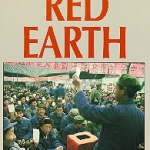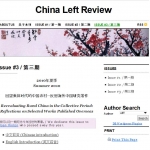Articles in the Chinese Revolutionary History Category
Great Leap Forward, Reviews »

Excerpts from Cormac Ó Gráda’s review of new book by Dikötter, Mao’s Great Famine. “MGF may become the best-known account of the GLF famine for a while. But should it? It is not a comprehensive account of the famine; it is dismissive of academic work on the topic; it is weak on context and unreliable with data; and it fails to note that many of the horrors it describes were recurrent features of Chinese history during the previous century or so…”
Chinese Revolutionary History, Husunzi, Reviews, Rural China »

John Lowrie criticizes my alleged use of the concept of “state capitalism” to analyze Mao-era socialism and the “people’s commune” system (in my review of Red Earth by Stephen Endicott, published issue #3 of China Left Review), and he proposes an alternative program for the transition to communism. Here I respond to both comments, clarifying the position introduced in my review.
China Left Review, Chinese Revolutionary History, CSG Announcements »

Issue #3 of China Study Group’s bi-lingual web-journal China Left Review is focused on new essays, by Chinese and overseas writers, revisiting several English-language books about rural China during the collective/ “people’s commune” era (ca. 1957-1982). The issue also includes an article on China’s ongoing land-tenure debate, and one on Sino-Korean relations. With the exception of the latter article, every text is presented in both Chinese and English versions - a first for this journal which we hope to continue. (If you’d like to help out with translating, revising or writing for future issues, please contact [email protected].) Also note the new design of the CLR website, including the painting “Iron Bones Giving Birth to Spring” (铁骨生春).
Chinese Revolutionary History, Contemporary China, International Observer »

For much of the working class and oppressed communities in India, the Chinese “model” is not its current capitalist market system, but the socialist revolution that preceded it under the leadership of Mao. In both nations the desperation of hundreds of millions in the face of “globalization” is growing, now heightened by the worldwide capitalist crisis. Though each government has shown an ability to buffer some of the worst effects of this collapse, and taken recent measures to ameliorate the burdens on the working classes, in the longer run they will not be able to escape the growing contradictions of world capitalism. Already, in both China and India, protests against ever widening polarization, impoverishment, corruption, land thievery and ecological devastation are growing in number, size and violence. For the Chinese, who had a revolution and then turned back to the capitalist road, it would take a major reversal to once again move toward socialism. India never had a similar revolutionary socialist transformation, but the forces to carry it out are stronger now than ever. The Indian and Chinese working classes and leftist forces today increasingly face parallel conditions under global capitalism led by an imperial United States. Though they have little contact at present, the future may bring a new unity, as the contradictions of the world capitalist system deepen and drive them more closely together.

